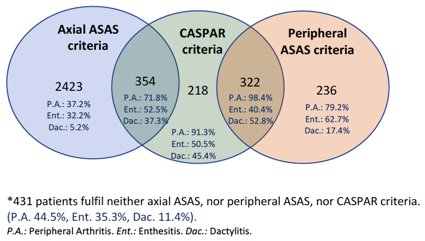Session Information
Date: Sunday, October 21, 2018
Session Type: ACR Poster Session A
Session Time: 9:00AM-11:00AM
Background/Purpose:
Peripheral manifestations (arthritis, enthesitis and dactylitis) can be observed in patients with Spondyloarthritis (SpA), but the factors associated with their presence are not well known. Studies are needed in order to thoroughly evaluate these symptoms. For this, we conducted an analysis aiming to: a) describe the prevalence of peripheral manifestations in patients with SpA in a world-wide population; b) determine the factors associated with the presence of these manifestations.
Methods:
Data from the ASAS-COMOSPA study were analysed. The prevalence of each peripheral manifestation was evaluated with regard to the criteria fulfilled by the patient (ASAS axial, ASAS peripheral, CASPAR) and with regard to the time of occurrence of axial symptoms (before/concomitant/after). Factors associated with the presence of these peripheral manifestations were also explored by univariate and multivariate logistic regression.
Results:
Out of the 3984 patients included in ASAS-COMOSPA, 2562 (64.3%) reported, at least, one peripheral manifestation. Among these, 2051 patients (51.5% from the total database) had current or past history of peripheral arthritis, being more frequent among patients who met CASPAR and Peripheral ASAS criteria (see Figure 1). Involvement was more frequently oligoarticular (40.2%) and appearing after axial symptom onset (48.9%). Multivariate analysis showed that patients from South America [OR 2.01, (95%CI 1.54 Ð 2.64)], the presence of enthesitis [OR 2.48, (95%CI 2.13 Ð 2.88)], dactylitis [OR 6.62, (95%CI 4.09 Ð 8.93)], skin psoriasis [OR 3.79, (95%CI 2.90 Ð 4.96)], HLAB27+ [OR 0.81, (95%CI 0.69 Ð 0.94)] and inflammatory back pain (IBP) [OR 0.81, (95%CI 0.69 Ð 0.94)] were associated with peripheral arthritis.
A total of 1506 (37.8%) and 618 (15.6%) patients reported enthesitis and dactylitis, respectively. Both occurred after axial symptoms onset in 58.3% and 60.8% of the patients, respectively. Similar results than peripheral arthritis were obtained in the multivariate analysis regarding these two peripheral manifestations, with exception of IBP and HLAB27+, which were not associated with enthesitis.
Conclusion:
Peripheral manifestations appear in 64% of patients with SpA and in more than 50% after axial symptoms onset. Peripheral arthritis, were more frequently mono- or oligo- rather than poly-articular, and the presence of psoriasis or any of the three peripheral manifestations acts as risk factor for the development of other peripheral symptoms.
Figure 1: Venn diagram.
To cite this abstract in AMA style:
López-Medina C, Molto A, Dougados M. Prevalence and Factors Associated with Peripheral Manifestations in Spondyloarthritis. an Ancillary Analysis of the ASAS-Comospa Study [abstract]. Arthritis Rheumatol. 2018; 70 (suppl 9). https://acrabstracts.org/abstract/prevalence-and-factors-associated-with-peripheral-manifestations-in-spondyloarthritis-an-ancillary-analysis-of-the-asas-comospa-study/. Accessed .« Back to 2018 ACR/ARHP Annual Meeting
ACR Meeting Abstracts - https://acrabstracts.org/abstract/prevalence-and-factors-associated-with-peripheral-manifestations-in-spondyloarthritis-an-ancillary-analysis-of-the-asas-comospa-study/

